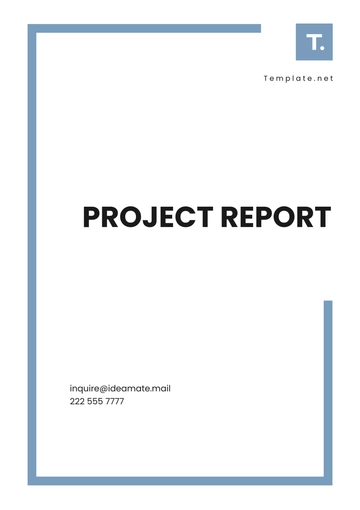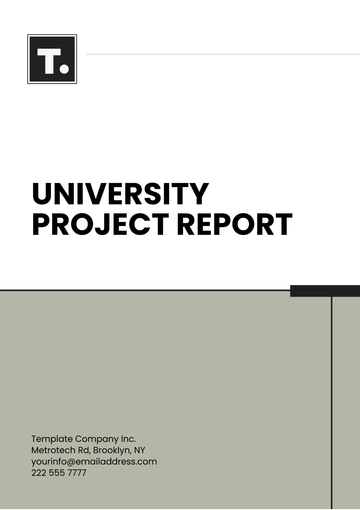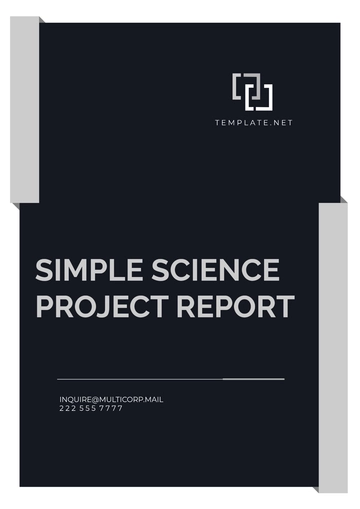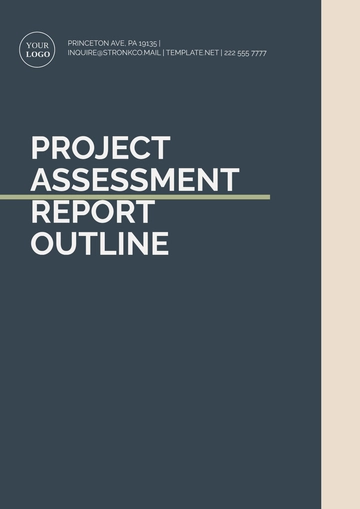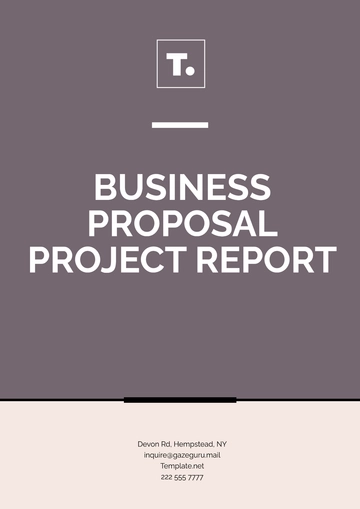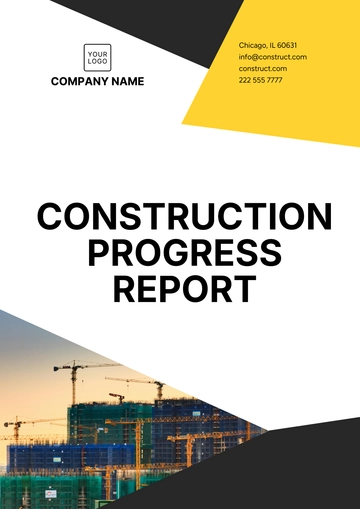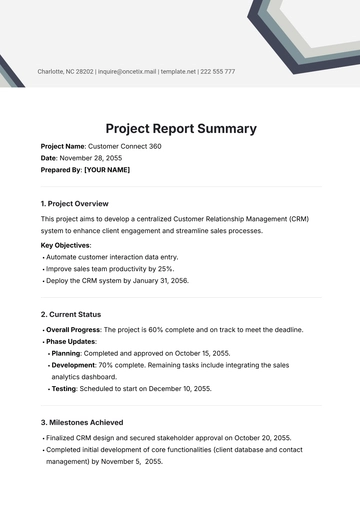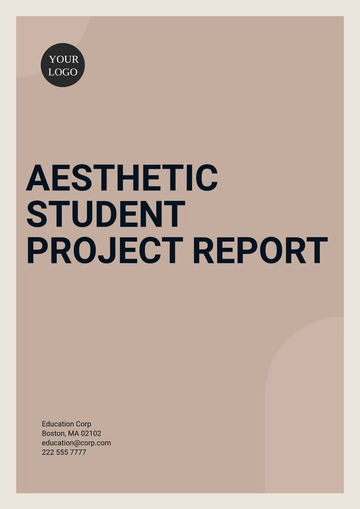Free Landscaping Report
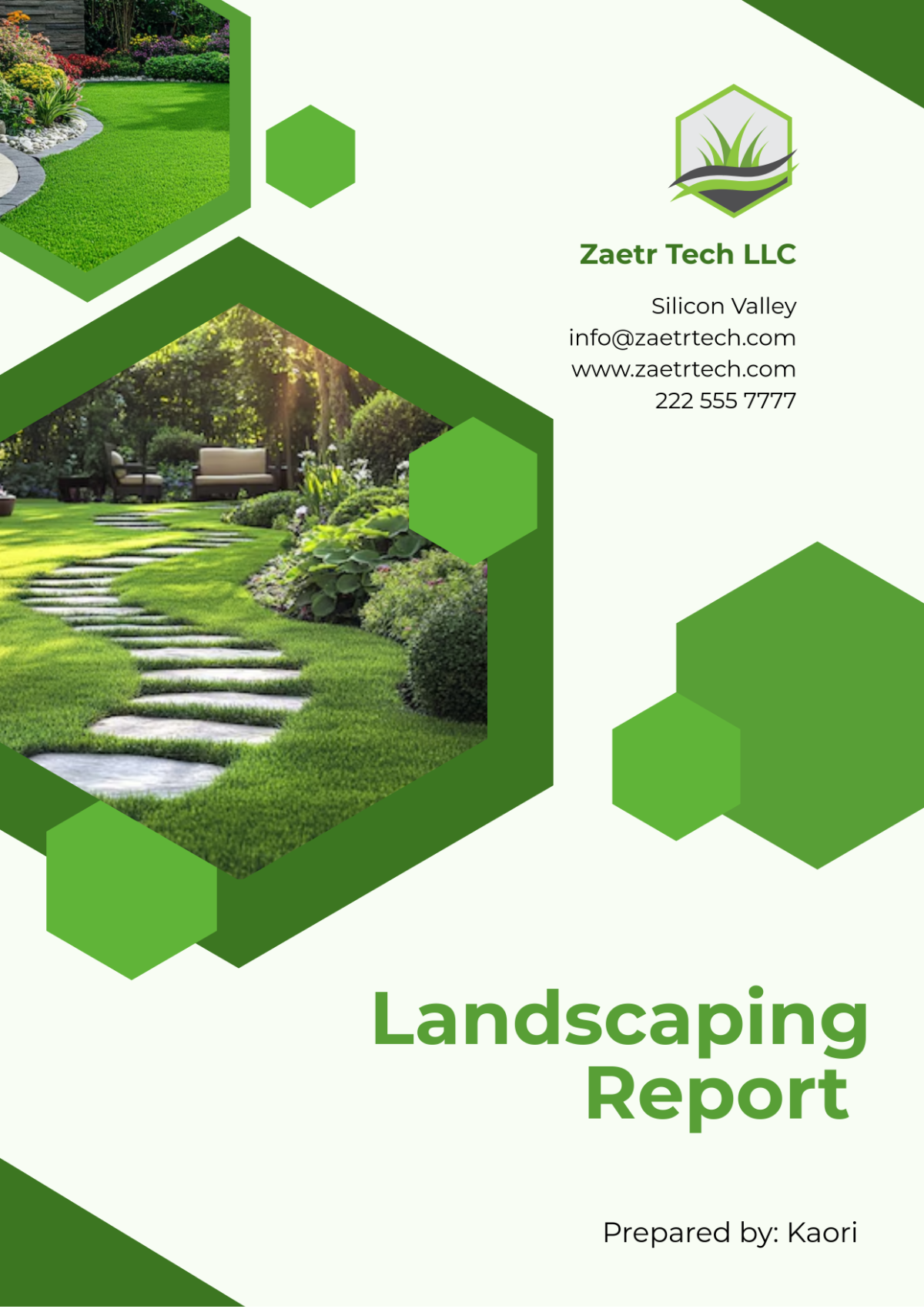
1. Introduction
Landscaping is a crucial aspect of property management that significantly impacts aesthetics, functionality, and environmental sustainability. As urbanization increases, maintaining a well-designed landscape becomes increasingly important for businesses, not only to attract clients and visitors but also to create a pleasant working environment for employees. This landscaping report aims to provide a detailed assessment of the current landscape at [Your Company Name], located at [Your Company Address]. Through this report, we will evaluate existing landscape conditions, identify potential improvements, and recommend strategies that align with contemporary landscaping trends and sustainable practices.
2. Objectives
The primary objectives of this landscaping report are as follows:
2.1. Assess Current Landscape Conditions
To create a successful landscaping plan, it is essential to understand the existing conditions of the landscape. This assessment will include:
Evaluation of Existing Vegetation: A thorough inspection will help identify the health and diversity of the plants, trees, and shrubs currently on the property. This will include evaluating their growth patterns, signs of diseases, and compatibility with the surrounding environment.
Soil Analysis: Analyzing the soil composition, quality, and nutrient levels will provide insights into the soil's ability to support various plant species. The results will guide the selection of appropriate plants and necessary soil amendments.
Irrigation Systems: Assessing the current irrigation systems for efficiency and effectiveness will highlight any areas needing improvement or modernization. Proper irrigation is vital for maintaining healthy landscapes, especially during dry seasons.
2.2. Identify Improvement Opportunities
After evaluating the current landscape conditions, we will identify specific areas for improvement. These opportunities will encompass:
Aesthetic Enhancements: Exploring options for enhancing the visual appeal of the landscape through creative design and plant selection will be a primary focus. The goal is to create an inviting atmosphere that reflects the company’s brand and values.
Functional Improvements: Assessing how the landscape can be modified to better serve the needs of [Your Company Name] will involve looking at outdoor spaces for employee gatherings, recreational activities, and community events. These spaces should be versatile and encourage interaction.
Sustainability Initiatives: Identifying opportunities for implementing environmentally friendly practices, such as the use of native plants, water-efficient irrigation systems, and sustainable maintenance practices, will ensure that the landscaping not only enhances aesthetics but also minimizes environmental impact.
2.3. Develop a Comprehensive Landscaping Plan
The development of a comprehensive landscaping plan will include:
Design Recommendations: Creating design concepts that integrate both functionality and aesthetic appeal will be essential. This may involve the use of software for visualizing the proposed changes.
Plant Selection: Recommending plant species that are suitable for the local climate, soil conditions, and intended use will be crucial to the success of the landscape. Native plants will be prioritized to enhance biodiversity.
Implementation Strategy: Outlining a phased approach for executing the landscaping improvements, including timelines and budget estimates, will ensure that the project is manageable and can be completed within the desired timeframe.
3. Current Landscape Assessment
3.1. Site Overview
[Your Company Name]’s property encompasses an area of approximately [15,000] square feet. The landscape includes a mixture of existing trees, shrubs, and open grassy areas, making it a versatile space for various uses, such as employee outdoor breaks, events, and visual appeal for visitors. The site is located in Austin, Texas, characterized by a humid subtropical climate. This climate type plays a crucial role in determining the types of plants that will thrive in the area, with long, hot summers and mild winters. The average annual rainfall is about 35 inches, which allows for a wide variety of native and drought-tolerant plants to thrive, but careful consideration must be given to irrigation during the summer months to maintain a healthy landscape.
The property also has existing landscape features such as [7] large live oak trees, several rows of crepe myrtle trees, and a mixture of decorative shrubs like boxwoods and loropetalum. The open grassy areas span approximately [5,000] square feet, though some sections of the lawn exhibit poor growth due to heavy shade from the trees and improper irrigation.
Additionally, the site features two stone pathways leading to the main building entrance and a small, paved seating area that serves as an outdoor employee break spot. However, the existing landscape requires a cohesive redesign to better utilize the space, enhance functionality, and reflect [Your Company Name]'s commitment to sustainability and modern aesthetics.
Table 1: Current Landscape Features
Feature | Description | Condition |
|---|---|---|
Trees | [5] Oak trees, [3] Maple trees, [2] Pine trees | Good |
Shrubs | [10] Various shrubs (e.g., Azaleas, Boxwoods) | Fair |
Grassy Areas | Approximately [4,000] square feet of lawn | Poor |
Pathways | [2] Main pathways, [1] gravel path | Fair |
Flower Beds | [3] Flower beds with seasonal blooms | Poor |
The site is currently functional but lacks the vibrancy and organization that a well-planned landscape could provide. The existing trees, particularly the oak and maple, add character and shade to the property, making them valuable assets.
3.2. Vegetation Health
An assessment of the current vegetation reveals a mixture of healthy and declining plants. The oak and maple trees appear healthy and robust, contributing positively to the overall landscape. However, several shrubs exhibit signs of distress, including wilting and discoloration, indicating that they may need replacement or specialized care.
3.2.1. Trees
The oak and maple trees on-site provide significant shade and aesthetic value. Their health suggests proper care in terms of watering and maintenance. Regular pruning is recommended to promote healthy growth and maintain their structure. For instance, pruning the lower branches of the oak trees can enhance their visual appeal and allow more light to reach the grass below.
In addition, the pine trees, although fewer in number, could be strategically utilized to create a backdrop or windbreak, adding to the landscape's functionality. Given their evergreen nature, they will provide year-round interest and protection from harsh winds during winter.
3.2.2. Shrubs
The shrubs present in the landscape require immediate attention. Signs of pests and disease have been noted, with potential threats to their longevity. A more diverse planting strategy should be employed to mitigate risks associated with monoculture plantings. For example, introducing a variety of shrubs like Hydrangeas, Roses, and Barberry can create a layered look and attract different pollinators.
A detailed inspection will be necessary to identify specific diseases affecting the shrubs, such as aphids or powdery mildew, and appropriate treatments should be implemented. Replacing distressed shrubs with healthier varieties that are more resistant to local pests could enhance the overall resilience of the landscape.
3.3. Soil Quality Analysis
Soil samples were taken from multiple locations across the property. The analysis revealed the following results:
Table 2: Soil Quality Analysis
Property | Value | Recommended Range |
|---|---|---|
pH Level | [6.5] | [6.0] - [7.0] |
Organic Matter | [2.5%] | [3.0%] - [5.0%] |
Nitrogen (N) | [0.15%] | [0.25%] - [0.35%] |
Phosphorus (P) | [20 ppm] | [25 ppm] - [50 ppm] |
Potassium (K) | [100 ppm] | [100 ppm] - [200 ppm] |
The soil's pH level is within an acceptable range for most plants, suggesting that there are no immediate issues with acidity or alkalinity. However, the nitrogen and organic matter content is below ideal levels, indicating a need for soil amendments to support healthier plant growth. For instance, the addition of compost or organic fertilizers can enhance the soil’s nutrient profile.
Regular soil testing should be instituted, with a plan to amend the soil annually. This will help ensure that the soil remains nutrient-rich and supports the diverse plant life envisioned for the landscape.
4. Improvement Opportunities
4.1. Aesthetic Enhancements
Creating a visually appealing landscape involves thoughtful design and plant selection. Some potential enhancements include:
Colorful Flower Beds: Introducing vibrant flower beds with a variety of annuals and perennials will provide seasonal color and attract pollinators. For example, planting Marigolds, Petunias, and Zinnias can create a stunning visual impact. Rotating seasonal flowers will ensure continuous blooms throughout the year.
Pathway Redesign: Upgrading existing pathways with decorative stone or pavers can improve accessibility and aesthetic appeal. Incorporating natural curves can create a more organic flow throughout the landscape, encouraging visitors to explore the property. Additionally, lighting along pathways can enhance safety and create an inviting atmosphere during evening hours.
4.2. Functional Improvements
Functional enhancements can help maximize the usability of outdoor spaces. Key recommendations include:
Outdoor Gathering Spaces: Creating designated areas with seating, fire pits, or tables will encourage outdoor gatherings and activities for employees and visitors. For instance, a gazebo or pergola with comfortable seating could serve as an ideal spot for employee breaks or informal meetings, fostering a sense of community.
Bicycle Racks: Installing bicycle racks can promote eco-friendly transportation options for employees. This not only encourages healthy commuting but also aligns with sustainability initiatives that [Your Company Name] may wish to pursue.
4.3. Sustainability Initiatives
Sustainability is increasingly important in landscaping. Recommended initiatives include:
Native Plant Landscaping: Using native plants will reduce water usage, enhance local biodiversity, and decrease maintenance requirements. Plants such as Black-eyed Susans, Coneflowers, and Native Grasses require less irrigation once established and can thrive in local soil conditions.
Rain Gardens: Installing rain gardens can help manage stormwater runoff, improve drainage, and create a unique landscape feature. These gardens can be designed to capture and filter rainwater, thus promoting groundwater recharge and reducing the burden on municipal drainage systems.
5. Comprehensive Landscaping Plan
5.1. Design Recommendations
The landscaping design will incorporate a blend of functional spaces and aesthetic features. Key components of the design include:
Zoned Areas: Dividing the landscape into zones such as relaxation, activity, and conservation will create a structured yet inviting atmosphere. For example, a quiet zone with benches and shade trees could be established for relaxation, while a more vibrant area with picnic tables could serve as a gathering space.
Plant Groupings: Using groupings of plants based on height, color, and texture will add visual interest while ensuring that each plant has sufficient space to thrive. For instance, tall flowering plants could be placed at the back of flower beds, with shorter plants in front to create depth.
5.2. Plant Selection
The selection of plant species is crucial for achieving a successful landscape. Recommended plants for [Your Company Name]’s landscape include:
Table 3: Recommended Plant Species
Plant Name | Type | Light Requirement | Water Needs |
|---|---|---|---|
Purple Coneflower | Perennial | Full Sun | Moderate |
Red Maple | Tree | Full Sun to Part Shade | Moderate |
Blue Fescue | Grass | Full Sun | Low |
Butterfly Bush | Shrub | Full Sun | Moderate |
Black-eyed Susan | Perennial | Full Sun | Low to Moderate |
Japanese Maple | Tree | Part Shade | Moderate |
Ferns | Perennial | Shade | Moderate |
These species are well-suited to the local climate and soil conditions, and they require varying levels of water, which can help diversify the landscape and manage irrigation efficiently. Selecting a mix of annuals and perennials will ensure year-round interest and reduce the need for replanting every season.
5.3. Implementation Strategy
The implementation of the landscaping improvements will be carried out in a phased approach to manage costs and resources effectively. The phases are as follows:
Table 4: Implementation Phases
Phase | Description | Estimated Cost | Timeline |
|---|---|---|---|
Phase 1 | Site Preparation and Soil Amendment | $[5,000] | [Q1 2050] |
Phase 2 | Planting Trees and Shrubs | $[10,000] | [Q2 2050] |
Phase 3 | Flower Beds and Aesthetic Enhancements | $[7,000] | [Q3 2050] |
Phase 4 | Installation of Pathways and Functional Areas | $[8,000] | [Q4 2050] |
Phase 5 | Maintenance and Evaluation | $[3,000] | [Annually] |
Each phase is designed to build upon the previous one, ensuring a cohesive and well-planned approach to the overall landscaping project. For example, in Phase 1, soil amendments will be made before any planting occurs to ensure that the soil is in optimal condition for new plantings.
6. Budget Considerations
The overall budget for the landscaping project needs careful consideration. The estimated costs for each phase of the implementation plan are provided in Table 4. Additional considerations include:
6.1. Funding Sources
Identifying potential funding sources is essential for the successful execution of the landscaping improvements. Possible sources include:
Internal Budgets: Allocating funds from [Your Company Name]'s operating budget for landscaping improvements. A review of the current budget can help identify areas where savings can be redirected towards landscaping.
Grants and Incentives: Exploring available grants for environmental projects or sustainability initiatives from local government or nonprofit organizations. For example, the Local Environmental Agency offers grants for projects that enhance biodiversity and promote sustainable landscaping practices.
6.2. Maintenance Budget
A yearly maintenance budget should be established to ensure the longevity and health of the landscape. Estimated annual maintenance costs include:
Routine Maintenance: Regular mowing, trimming, and watering are essential to maintain the landscape’s appearance and health. The estimated cost for routine maintenance is approximately $[2,000] per year, covering all necessary upkeep.
Plant Replacement: Budgeting for the replacement of any dead or dying plants is crucial for maintaining the integrity of the landscape. An estimated cost of $[1,000] per year should be set aside for this purpose.
Soil Amendments: Annual soil testing and amendments to maintain soil health will incur an estimated cost of $[500] per year. This proactive approach will help avoid larger issues in the future and ensure plant vitality.
7. Conclusion
This landscaping report provides a comprehensive overview of the current landscape conditions at [Your Company Name] and outlines a strategic plan for enhancements that prioritize aesthetics, functionality, and sustainability. By implementing the recommendations in this report, [Your Company Name] can improve the visual appeal of its property, contribute positively to the environment, and enhance the overall experience for employees and visitors alike.
As [Your Company Name] moves forward with the proposed landscaping plan, it is essential to consider the long-term commitment to maintenance and sustainability. By fostering a beautiful and functional landscape, [Your Company Name] will create an inviting atmosphere that reflects its values and mission well into the future.
8. References
American Society of Landscape Architects. (2050). Sustainable Landscape Practices.
U.S. Department of Agriculture. (2050). Plant Hardiness Zone Map.
National Oceanic and Atmospheric Administration. (2050). Climate Data for [Location].
The International Society of Arboriculture. (2050). Tree Care Guidelines.
Local Government Agency. (2050). Environmental Grants and Resources.
- 100% Customizable, free editor
- Access 1 Million+ Templates, photo’s & graphics
- Download or share as a template
- Click and replace photos, graphics, text, backgrounds
- Resize, crop, AI write & more
- Access advanced editor
Document project outcomes with the Landscaping Report Template from Template.net. This editable and customizable template helps you present project details, client feedback, and maintenance recommendations clearly. Use our Ai Editor Tool to personalize it, ensuring effective communication of landscaping project results.
You may also like
- Sales Report
- Daily Report
- Project Report
- Business Report
- Weekly Report
- Incident Report
- Annual Report
- Report Layout
- Report Design
- Progress Report
- Marketing Report
- Company Report
- Monthly Report
- Audit Report
- Status Report
- School Report
- Reports Hr
- Management Report
- Project Status Report
- Handover Report
- Health And Safety Report
- Restaurant Report
- Construction Report
- Research Report
- Evaluation Report
- Investigation Report
- Employee Report
- Advertising Report
- Weekly Status Report
- Project Management Report
- Finance Report
- Service Report
- Technical Report
- Meeting Report
- Quarterly Report
- Inspection Report
- Medical Report
- Test Report
- Summary Report
- Inventory Report
- Valuation Report
- Operations Report
- Payroll Report
- Training Report
- Job Report
- Case Report
- Performance Report
- Board Report
- Internal Audit Report
- Student Report
- Monthly Management Report
- Small Business Report
- Accident Report
- Call Center Report
- Activity Report
- IT and Software Report
- Internship Report
- Visit Report
- Product Report
- Book Report
- Property Report
- Recruitment Report
- University Report
- Event Report
- SEO Report
- Conference Report
- Narrative Report
- Nursing Home Report
- Preschool Report
- Call Report
- Customer Report
- Employee Incident Report
- Accomplishment Report
- Social Media Report
- Work From Home Report
- Security Report
- Damage Report
- Quality Report
- Internal Report
- Nurse Report
- Real Estate Report
- Hotel Report
- Equipment Report
- Credit Report
- Field Report
- Non Profit Report
- Maintenance Report
- News Report
- Survey Report
- Executive Report
- Law Firm Report
- Advertising Agency Report
- Interior Design Report
- Travel Agency Report
- Stock Report
- Salon Report
- Bug Report
- Workplace Report
- Action Report
- Investor Report
- Cleaning Services Report
- Consulting Report
- Freelancer Report
- Site Visit Report
- Trip Report
- Classroom Observation Report
- Vehicle Report
- Final Report
- Software Report
